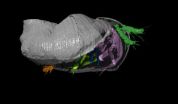(Press-News.org) How does evolution innovate? We exist because our ancestors have had the ability to adapt successfully to changes in their environment; however, merely examining present-day organisms can limit our understanding of the actual evolutionary processes because the crucial events have been masked by the passage of aeons – what we need is a time machine. Scientists from VIB, KU Leuven, University of Ghent and Harvard have done the next-best thing; by reconstructing DNA and proteins from prehistoric yeast cells, they were able to directly examine the evolutionary forces that have acted over the last 100 million years to shape modern-day enzymes – biological catalysts that enable organisms to manipulate molecules to their will.
The scientists set out to explore how new genes emerge, how they contribute to the survival of the evolving organism, and how, after a humble start, evolution then refines the function of new genes and hones the efficiency of the enzymes that they encode. One of the richest sources of such new genes is the chance duplication of existing genes. One copy of the gene can then continue to encode the original enzyme, allowing it to perform its original task, while the other is free to change and to perhaps take on a new function; alternatively, the two new enzymes might sub-divide the original task.
Although this pattern of innovation is known to have happened many thousands of times during evolution, the way in which it occurs hasn't been clear. In a paper published December 11 in the online Open Access journal PLOS Biology, Karin Voordeckers, Chris Brown and Kevin Verstrepen from VIB in Leuven, together with Steven Maere from VIB and the University of Ghent, tackled this problem, focusing their attention on the evolution of enzymes that have allowed yeast to exploit changing food sources over the last 100 million years of evolution.
The scientists 'resuscitated' ancestral yeast genes, allowing them to examine the properties of enzymes that existed tens of millions of years ago. The original enzyme originally enabled the yeast cells to survive on a diet of maltose, a common sugar, but duplications of their genes gave rise to new enzymes which opened up the possibility of feeding off other types of sugar in the environment. The resurrection of these enzymes meant that the scientist could build up a detailed picture of their atomic structure and directly determine their ability to break down different types of sugars. Armed with this information, they could work out exactly how the enzymes had changed their specificity and how evolution drove their optimisation.
"We used sequence reconstruction algorithms to predict the DNA sequence of ancestral genes from dozens of present-day DNA sequences. This enabled us to rebuild the corresponding ancestral proteins and compare them with those present today", said Steven Maere.
"We searched very specifically for how the yeast adapted to break down various sources of sugar. We found that the primal gene that codes for the protein for the digestion of maltose – a sugar in grain – was copied a number of times during evolution. The DNA of some copies changed slightly, resulting in new proteins that could break down different sugars. By modeling these changes in the corresponding proteins, we now understand how just a few changes in the DNA can lead to the development of a completely new activity in the corresponding proteins", said Karin Voordeckers.
"New functional DNA does not appear out of thin air, but is built up gradually from a copy of an existing segment of functional DNA. By reconstructing a piece of prehistoric DNA that was copied several times during evolution, we were able to investigate in detail which changes occur in each of the copies and gradually lead to new functions. As such, our results provide a unique and detailed view into the molecular details of Darwinian evolution" says Kevin Verstrepen.
The scientists propose that the events observed here in the yeast cell's quest for sugar may reflect a general strategy widely used for innovation in evolution.
###
Funding: S. Maere and K. Vanneste are fellows of the Fund for Scientific Research-Flanders (FWO). Research in the lab of KJV is supported by the Human Frontier Science Program, ERC Starting Grant 241426, VIB, EMBO YIP program, KU Leuven, FWO, IWT and the AB InBev Baillet-Latour foundation. Research in the lab of SM is supported by VIB, Ghent University, FWO and IWT. The funders had no role in study design, data collection and analysis, decision to publish, or preparation of the manuscript.
Competing interests: The authors have declared that no competing interests exist.
Citation: Voordeckers K, Brown CA, Vanneste K, van der Zande E, Voet A, et al. (2012) Reconstruction of Ancestral Metabolic Enzymes Reveals Molecular Mechanisms Underlying Evolutionary Innovation through Gene Duplication. PLOS Biol 10(12): e1001446.
doi:10.1371/journal.pbio.1001446
CONTACT:
Kevin J. Verstrepen
VIB and KULeuven
Systems Biology
Gaston Geenslaan 1
Bio-Incubator
Lab CMPG / VIB
Leuven, 3001
BELGIUM
32-495-384-215
Kevin.Verstrepen@biw.VIB-KULeuven.be
Disclaimer:
This press release refers to an upcoming article in PLOS Biology. The release is provided by journal staff, or by the article authors and/or their institutions. Any opinions expressed in this release or article are the personal views of the contributors, and do not necessarily represent the views or policies of PLOS. PLOS expressly disclaims any and all warranties and liability in connection with the information found in the releases and articles and your use of such information.
About PLOS Biology:
PLOS Biology is an open-access, peer-reviewed journal published by PLOS, featuring research articles of exceptional significance, originality, and relevance in all areas of biology. Copyright on all works is retained by the authors. PLOS uses the Creative Commons Attribution License.
About PLOS:
PLOS is a non-profit organization of scientists and physicians committed to making the world's scientific and medical literature a freely available public resource. For more information, visit http://www.plos.org.
Women who are even light-to-moderate cigarette smokers may be significantly more likely than nonsmokers to suffer sudden cardiac death, according to new research in Circulation: Arrhythmia & Electrophysiology, an American Heart Association journal.
The findings indicate long-term smokers may be at even greater risk. But quitting smoking can reduce and eliminate the risk over time.
"Cigarette smoking is a known risk factor for sudden cardiac death, but until now, we didn't know how the quantity and duration of smoking effected the risk among apparently healthy women, nor ...
Washington, DC — Brain changes in children who have sustained a mild traumatic brain injury, or concussion, persist for months following injury — even after the symptoms of the injury are gone, according to a study published in the December 12 issue of The Journal of Neuroscience. The findings highlight the potential benefit of using advanced imaging techniques to monitor recovery in children following concussions.
Despite growing concerns over the risk of concussions in youth, the majority of research examining their effects on the brain has involved adults. These ...
A Cochrane review of studies into manipulative therapies for colic, by the University of Southampton, suggests that the treatment technique may be of some benefit.
Infantile colic is a distressing problem, characterised by excessive crying of infants and it is the most common complaint seen by physicians in the first 16 weeks of a child's life.
It is usually considered a benign disorder because the symptoms generally disappear by the age of five or six months. However, the degree of distress caused to parents and family life is such that physicians often feel the ...
'It is exciting to discover that a common group of fossils that we thought we knew a lot about may well have been hood-winking us as to their true identity, which we now realise because we have their beautifully fossilised soft-parts. A case of a 'wolf in sheep's clothing''- Professor David Siveter, University of Leicester
An international team of researchers have made an extremely rare discovery of a species of animal - related to crabs, lobsters and shrimps – that is new to science.
Scientists from the universities of Leicester, Oxford, Imperial and Yale have announced ...
The long necked sauropod dinosaurs were the largest land animals ever to walk the Earth – but why were they so large? A decade ago a team of plant ecologists from South Africa suggested that this was due to the nature of the plant food they ate, however these ideas have fallen out of favour with many dinosaur researchers. Now Liverpool John Moores University's (LJMU's) Dr David Wilkinson and Professor Graeme Ruxton of University of St Andrews, Scotland, argue that this idea still has legs.
The results have been published in the journal Functional Ecology published by ...
Medical researchers at the University of Alberta have discovered a drug intended for diabetes appears to restore memory in Alzheimer's brain cells.
Jack Jhamandas, a researcher with the Faculty of Medicine & Dentistry at the U of A, is the principal investigator with the team whose research results were recently published in the peer-reviewed publication The Journal of Neuroscience. He works in the Division of Neurology.
The team took brain tissue from animal models with Alzheimer's disease and tested the tissue in the lab, looking specifically at the cells' memory ...
DURHAM, N.C. -- High-speed video of projectiles slamming into a bed of disks has given scientists a new microscopic picture of the way a meteorite or missile transfers the energy of its impact to sand and dirt grains.
The transfer is jerky, not smooth. "It was surprising just how unsmooth the slow-down of the intruding object was," Duke physicist Robert Behringer said. His team describes their new videos and impact analysis in the Dec. 7 Physical Review Letters. The research may change the way scientists model meteorite and missile impacts and their effects.
Scientists ...
WASHINGTON (Dec. 11, 2012) – New research, presented this morning at the 54th Annual Meeting of the American Society of Hematology (ASH), has identified important associations between Plasmodium falciparum (Pf) malaria and endemic Burkitt Lymphoma (eBL) that may help researchers identify young children who are more susceptible to eBL.
Unlike previous studies in which malaria infection alone was considered the important factor, this study approached the evolving complexity and heterogeneity of the humoral immune response to Pf as a key component for risk of developing ...
Rose madder – a natural plant dye once prized throughout the Old World to make fiery red textiles – has found a second life as the basis for a new "green" battery.
Chemists from The City College of New York teamed with researchers from Rice University and the U.S. Army Research Laboratory to develop a non-toxic and sustainable lithium-ion battery powered by purpurin, a dye extracted from the roots of the madder plant (Rubia species).
More than 3500 years ago, civilizations in Asia and the Middle East first boiled madder roots to color fabrics in vivid oranges, reds ...
LEXINGTON, Ky. (Dec. 10, 2012) — A research team composed of University of Kentucky researchers has published a paper which provides the first direct evidence that activated astrocytes could play a harmful role in Alzheimer's disease. The UK Sanders-Brown Center on Aging has also received significant new National Institutes of Health (NIH) funding to further this line of study.
Chris Norris, an associate professor in the UK College of Medicine Department of Molecular and Biomedical Pharmacology, as well as a member of the faculty at the UK Sanders-Brown Center on Aging, ...

